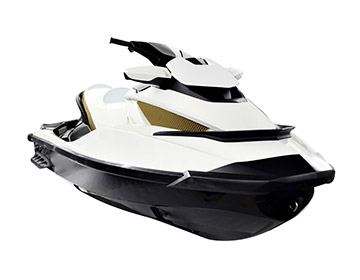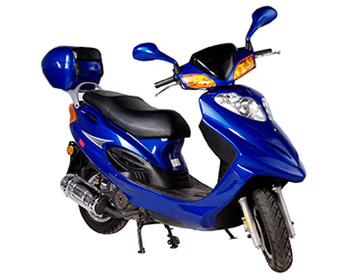History of the Modern ATV and UTV
Feb 21st 2018
History of the Modern ATV and UTV

Ever since humans have inhabited the Earth,
we’ve been a race of natural wanderers and explorers. Our inquisitive nature has led us through all across the known world as well as far into the unknown. First, by way of on-foot travel. Then, on the backs of beasts, through man-powered simple craft, all the way up to fully-mechanical transport. As such, we’ve also altered the environment along the way. Eons of paved roads carve and slice through once-untouched forests, mountains, desert plains, and grasslands; even stretching across large bodies of water or tunneling underneath to connect otherwise difficult-to-reach land masses. Today, humans rely on these streets and superhighways for daily commuting to get from point A to point B but there are still many of us who prefer to venture off-course and away from civilization.
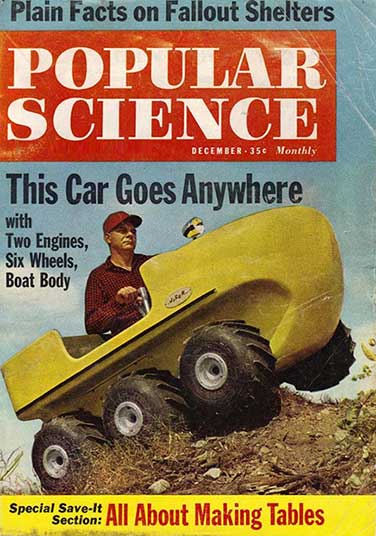
The Jiger ATV, as seen in this December 1961 issue of Popular Science.
Previously, off-roading was limited to dirt bikes, heavy-duty 4X4 pickup trucks, and Jeeps but in 1965, the Jiger Corporation out of Toronto, Canada developed the first-ever amphibious all-terrain vehicle (ATV) for military use. The Jiger ATV took the lightweight and compact mechanical structure of a dirt bike or motorcycle and combined it with the rugged durability of a pickup. It was a (relatively) nimble, extended range alternative to large, cumbersome vehicles that could navigate through areas that were too challenging or spatially-limited for a full-size vehicle to traverse.
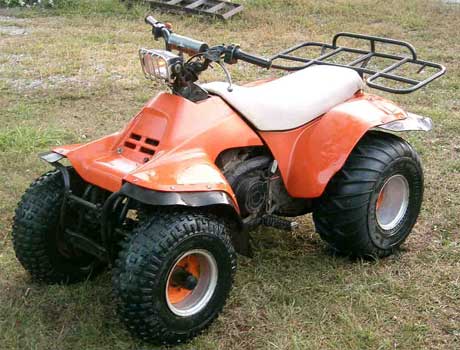
1982 Suzuki LT125
The success of the Jiger ATV inspired other motorcycle and power equipment manufacturers to attempt to capitalize on its popularity. In the process, 3-wheeled power tricycles such as the Sperry-Rand Tricart and Honda ATC90 (previously known as the US90) took precedence over the 6-wheeled Jiger design and, for a while, these were the predominant type of ATV in the market. However, in 1982, Japanese manufacturing titan Suzuki developed the first 4-wheel ATV, the LT125, and forever influenced the architecture of all modern ATVs that followed. The LT125 was originally a budget-friendly model aimed at beginners but it soon saw mass-market, professional-level competition such as the 1984 Honda TRX200, 1985 Yamaha Moto-4 YFM200, and 1985 Kawasaki Bayou 185. Suzuki responded with another innovation: the first mini 4-wheel ATV, the LT50, in 1984 and the LT80, the first ATV to use a CVT (continuously variable transmission), three years later. Suzuki was now the undisputed leader in ATV development and innovation. In 1987, the company turned their attention to speed, muscle, and high-performance with the Banshee 350. The Banshee 350 utilized the same 47 horsepower, liquid-cooled 2-cylinder 2-stroke from the Yamaha RD350LC sport bike. Shortly after the debut of the Banshee 350, Suzuki’s most infamous ATV model, the LT500R Quad Racer, became available to the ATV and off-road quad public. Nicknamed “Quadzilla”, due to its massive size and power, the LT500R remains today as the the fastest 4-wheel production ATV ever made with a top speed of 79 MPH. Naturally, as high-performance ATVs gained popularity, Quad Racing and ATV Motocross enjoyed massive growth and exposure in the late 1980s. These forms of motorsport blended the classic English motorcycle trials with off-road motorcycle racing and Baja racing, but now with the added challenge of heavyweight 4-wheel ATVs.
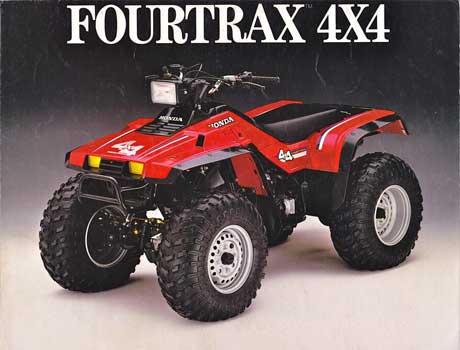
1986 Honda FourTrax sales brochure
Alternately, while ATVs were being used to satisfy the need for adventure by speedfreaks and motorheads, the utilitarian capabilities of the ATV were also being explored. Honda’s 1986 FourTrax TRX350 is credited with bringing forth the age of the 4-wheel drive ATV and competing manufacturers soon followed suit, thus finalizing the evolution of the modern ATV. The 4X4 drivetrain layout not only granted expanded off-road competence, but also allowed for greater customer accessibility in the powersports market. 4X4 ATVs quickly found popularity with hunters and outdoor sporting enthusiasts, ranchers, farmers, construction and demolition crews, even with national and local government employees such as police, fire, emergency services, and park rangers.
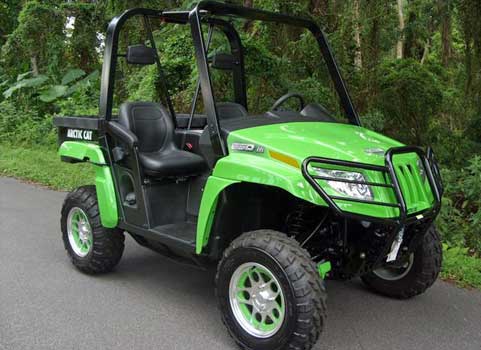
2006 Arctic Cat Prowler 650 XT
In 2006, a genealogical offshoot of the ATV appeared with Arctic Cat’s Prowler. Called a ‘side-by-side’ or UTV (utility vehicle, or utility task vehicle, or unlimited-terrain vehicle), the Prowler had the mobility and compact build of an ATV, but it was less motorcycle-influenced and more directly inspired by off-road vehicles such as Jeeps, pickup trucks, and dune buggies. The Arctic Cat Prowler UTV featured side-by-side bucket seating with seat belts, rollover protection (such as roll bars, safety cage construction, and an optional roof) a rear cargo bed, higher load capacity, and longer and wider dimensions than that of an ATV. Polaris Industries introduced their own UTV effort in 2007 with the Ranger RZR (as a 2008 model year vehicle). UTVs experienced a popularity boom in the late 2000s as the economy worsened and ATVs temporarily suffered a worldwide slump in sales. Consequently, powersports manufacturers such as Bombardier and Can-Am, Yamaha, Honda, Husqvarna, Kawasaki, and John Deere (among countless others) wanted a piece of the action and released their own respective UTV models.

Today, both ATVs and UTVs enjoy widespread use for recreational, utility, and commercial purposes. The basic structures of ATVs and UTVs have remained fairly unchanged over the years but recent technological advancements in standard equipment, such as the inclusion of automatic transmissions and power steering systems, are rapidly closing the gap between off-road powersports vehicles and typical passenger vehicles. Will ATVs and UTVs eventually usurp the motor vehicle throne from our beloved cars and trucks? Doubtful, but one thing’s for sure: ATVs and UTVs aren’t going away anytime soon. As long as we continue to venture outside the boundaries of paved roads, streets, and highways, ATVs and UTVs will always be on duty.






